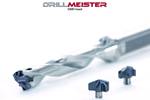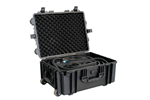Ball Nose Series Meets Rigors of Processing Hardened/Abrasive Steel
Boasting a new carbide blend, U.S. Union Tool’s HGB/HGLB Ball nose series can cut hardened/abrasive steels in the 59-70 HRC range, and improves overall tool life.

Photo Credit: Union Tool
The challenge when cutting steels greater than 60 HRC and moderate steels with abrasive properties lies with the cutting tool used in the process, says U.S. Union Tool Inc.. To address this challenge, the company introduces the HGB/HGLB Ball nose series, designed specifically for these types of applications, meeting the rigors of cutting hardened/abrasive steels in the 59-70 HRC range.
The series is said to be a new blend of carbide, emphasizing low tool wear and exceptional deflection resistance. Both HGB and HGLB series boast H4 shanks, negative rake angle point geometry, a ball radius accuracy +/- 0.002-0.005 mm, and a new HMG coating rated to 4200 Vickers hardness, which Union Tool says surpasses the current Hardmax coating. These tools are available in a diameter range of 0.10-6 mm and in varying lengths.
According to a case study of the HGB/HGLB series on HAP72 tool steel (69HRC), there was a 40% reduction in tool wear width, compared to a conventional cutting tool product. Further, Union Tool says the same volume of milling was processed with twice the efficiency using its series, exhibiting increased cost-effectiveness via improved tool life, without chipping.
Related Content
-
How to Eliminate Chatter
Here are techniques commonly used to combat chatter and guidelines to establish a foundation for optimizing the moldmaking process.
-
6 Ways to Optimize High-Feed Milling
High-feed milling can significantly outweigh potential reliability challenges. Consider these six strategies in order to make high-feed milling successful for your business.
-
Considerations for Mold Base Material Selection
Choosing the right material can greatly affect the profitability and cost of your application.





.jpg;maxWidth=300;quality=90)







